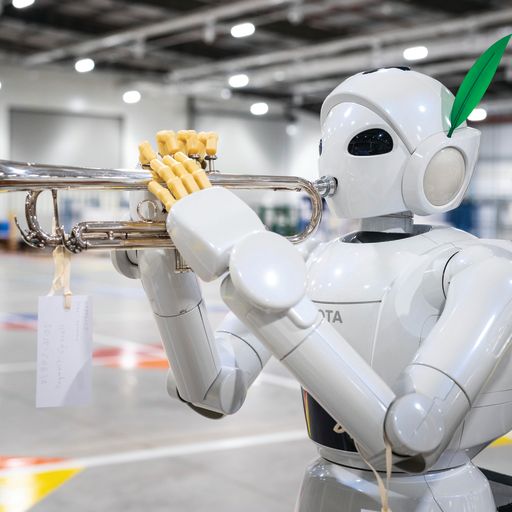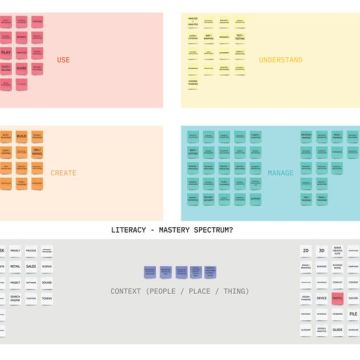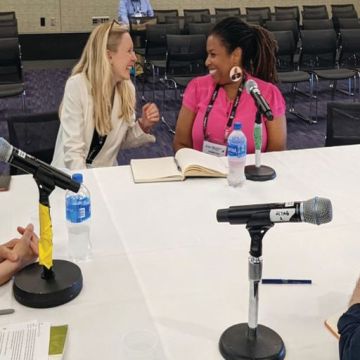
This article originally appeared in the November/December 2022 issue of Museum magazine, a benefit of AAM membership.
What it means to build a human-centered approach to digital leadership and skills.
People drive digital change in the museum. Irrespective of the focus on technology—hardware and software, standards and systems, products and platforms—it will always be the leaders and staff, the partners and stakeholders who enable the digital capability of museums.
And yet, the lived professional experience of individuals within museums working on digital change is little understood and much overlooked. Plainly put: the very dimension that we now know is fundamental to digital change in the museum is that which—in our practice and scholarship—we know the least.
Museums today not only are attempting to understand new forms of visitor participation and digital experience but are doing so within a moment of both institutional and individual precarity, making essential the need to understand the human (and not just the technical) dimension of museum digital change. Over the last two years, an international research collaboration has been investigating this human dimension along with how we define “digitally mature” in the museum space, why it matters, and how we can help museums get there.
Part of the ongoing One by One research consortium, “3 by 3” is an 18-month, multi-partner, transatlantic collaboration bringing together cultural institutions, academics, and professional organizations to help museums navigate digital change (see “A Unique Collaboration” sidebar on p. 54 for participants). The project has asked what new models of “empathic leadership” could enable the holistic institutional adoption of (and adaptation to) digital, what inequalities exist in the landscape of digital change in museums, and how these inequalities can be confronted. In doing so, “3 by 3” has attempted to highlight what successful digital leadership in museums looks like in human, not just business and technological, terms.
Embedding the Emotional in Digital
One “track” of the project has investigated the development of digital skills in the museum workplace. Previous work by the One by One team has shown the extent to which museums struggle to formalize the development of digital skills within their workforce, even lacking clarity on the definition of “digital skills” in a museum context. This latest study considers how we might close this gap between identifying skills and ensuring that the right skills are performed at the right time.
The project’s researchers employed a series of prompts and exercises (such as audience experience mapping) with project museums to delve deeper into the communication, collaboration, and digital skills development areas that would enable digital transformation. These activities were occasionally offered to the entire research cohort to complete together; otherwise, research partners conducted these activities with their respective museum teams. The prompts and exercises revealed opportunities for museums to achieve greater digital impact as they thoughtfully consider how digital is understood, used, managed, and created across their organization.
Following this fieldwork, 18 monthly book club study sessions, and the close review of over 250 museum digital job descriptions, the project created a new framework for identifying and articulating digital skills for museum workers. The new framework shows the combinations of technical, business, and emotional skills that together comprise digital skills in the museum.
Conceptually similar to the Periodic Table of Elements, the Periodic Table of Skills (PToS) is a framework to help museums understand and identify patterns and connections between skills while also acknowledging the human and emotional dimension to digital capability. The PToS currently has 207 skills across seven dimensions. These skills include foundational digital literacies, such as “to understand risks and threats in digital environments,” and emotional skills, such as being “inclusive” and “self-aware.”
The elements listed in the PToS are meant to be considered in combination with each other and their organization’s unique context and characteristics (i.e., domain-specific knowledge and technologies within the organization’s digital ecosystem). Doing so showcases the depth and breadth of digital capabilities such as “online community management” and “data management” and indicates the level of mastery needed within the organization.
This is much-needed clarity. After all, how can we develop skills if we are not clear what those skills are or how they are used in different combinations to achieve specific outputs and outcomes? One by One’s Periodic Table of Skills can potentially help individuals, teams, and organizations embed digital literacy into all job roles and functions; develop right-size job descriptions, professional development, and performance plans; and improve the employee experience.
The Hidden Emotionality of Digital Work
Complementing this new framing of digital skills and capabilities, the second research track focuses on everyday digital practices and behaviors across an organization and its workforce.
A year-long study by the Science Museum Group (SMG)—five UK science and technology museums—culminated in the October 2022 launch of The Hidden Constellation, a research podcast profiling the new, hidden, distributed, legacy, and collective forms of digital work taking place across this group. The premise of The Hidden Constellation is that emergent forms of digital labor in museums make up a constellation that when plotted and connected reveals a pattern of work that is as complex, overlapping, or hierarchical as more familiar and visible kinds of museum labor.
Often intangible, location-specific, under-valued, or under-articulated, this new constellation operates and agitates alongside other, more traditional forms of curatorial, conservation, and collections management work in the museum. Moreover, new forms of digital curatorship, digital content generation, hybrid working models, and the increasing role of data analytics are influencing, and sometimes reinforcing, and even disrupting, previous modes of power, knowledge, and expertise within the museum. Digital work in museums, as well as digital volunteering, digital storytelling, and other forms of digital participation, are giving rise to new, virtual, and hybrid opportunities for empathetic and supportive dialogue. This is pushing at existing institutional boundary lines; propelling play and experimentation; and—most significantly—inviting more people to the conversation.
This research has found that emergent practices of digital labor—in already digitally confident museum spaces such as Science Museum Group, at least—are collaborative, open-sourced, and radically transparent, involving a kind of maker culture or do-it-ourselves ethic. This was evident, for example, in the meme-collecting project led by the National Science and Media Museum (Bradford) in collaboration with Dr. Arran Rees from the University of Leeds.
The team decided to collect the Museum of English Rural Life’s infamous “absolute unit” tweet. This featured a 1962 photographic image of a farm animal—an Exmoor Horn ram—on sale at a livestock auction in Somerset, England. At the time of its original posting in 2018, this tweet was widely recognized by the museum world as a viral sensation, receiving over 100,000 likes and 29,000 retweets.
This project forced the museum’s existing collections staff to evolve how they think about ownership as well as how they collect a born-digital object with many component parts, including a TIFF, a Twitter handle, and a series of Twitter responses and
follow-up memes. It revealed the need for more digital preservation skills among staff along with new ways of thinking about curatorship when you catch a meme “in the wild,” which is likely to evolve online after it has been acquired.
There is an inherent emotionality to the “new power” philosophy—to borrow from Henry Timms and Jeremy Heimans’ 2018 book of the same name—behind much of the digital labor at Science Museum Group. It is quietly disrupting some of the more formal “old power” principles—the more managerial, exclusive aspects that are premised on an unwavering belief in the expertise of curators and on the long-term affiliation and loyalty of established audiences—that are foundational in many of today’s museums.

This latest research found that emergent digital labor involves intentional, purposeful, and effort-based actions of all who undertake it: in other words, it involves emotional labor. Often overused, this concept remains useful in the study of museums’ digital transformation work because it encompasses the need for analytical and intuitive skills, the understanding of various individual aspirations, and the well-honed interpersonal and negotiating skills required to broker digital change. However, this research has shown that, while emotional labor can enter museum technology discourse in productive ways, it can also be the source of exhausting, exploitative practices.
The One by One team’s ongoing research has found that, rather than uncritically accepting changes to museum working practices brought about through technological change, we must begin to question how digital labor is shifting experiences of work, including new kinds of under-articulated and hidden digital work now commonplace, such as in the realms of social media community management and content generation, museum documentation, and archival work. At the same time, we need to remain aware of how the emotional aspects of new forms of digital work in museums are precisely what is enabling emergent kinds of curatorship, programming, expertise, and participation.
Successful Digital Leadership

Leicester; Doretha Williams, National Museum of African American History and Culture; and Ross Parry, University of Leicester.
These two tracks of research have taken very different approaches: one a systematic study across multiple organizations informed by business process maturity modeling and the other an institutional ethnography centered on one museum group. Furthermore, each has produced different signature outputs: one an extensible framework for plotting evolving museum digital capability and the other episodic insights into the hidden emotionality of everyday digital work in the museum.
Both projects represent an “emotional turn” in museum technology. They highlight the importance of emotions and the subjectively experienced feelings that underpin digital transformation work in museums. Crucially, this research tells a story of museum digitalization in human, and not just business and technological, terms.
A Unique Collaboration
Led by the University of Leicester and Southern University at New Orleans (and advised by experts at Harvard University and Johns Hopkins University), the “3 by 3” research project has been a unique research collaboration. It has brought together the leading sector bodies in the UK and US: the American Alliance of Museums with the UK’s Museums Association, and the Museum Computer Network (US) with the Museums Computer Group (UK).
At the core of the project is a transatlantic partnership of cultural organizations, with digital leads across the Smithsonian Institution partnering with their counterparts in the Science Museum Group, Victoria and Albert Museum, Amgueddfa Cymru—National Museum Wales, and National Museums Scotland.
Resources
Periodic Table of Skills
miro.com/app/board/uXjVOuggJt0=/
The Hidden Constellation podcast series with Dr. Sophie Frost
shows.acast.com/thehiddenconstellation
People. Change. Museums. podcast series with Dr. Sophie Frost
leicester.figshare.com/collections/Voices_of_the_Royal_Pavilion_Museums_podcast/5118557
The Digital Culture Compass
digitalculturecompass.org.uk/
One by One case studies and guides on Culture24’s Digital Pathways
bit.ly/3coC8Wd







